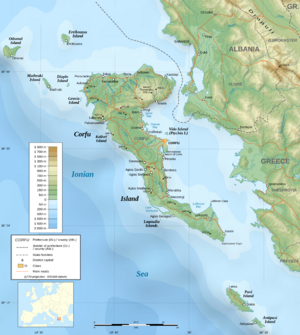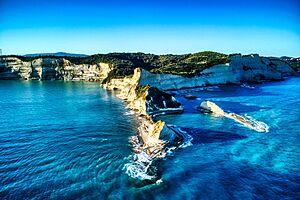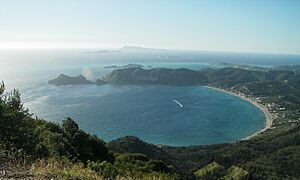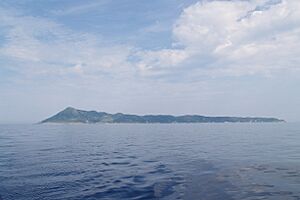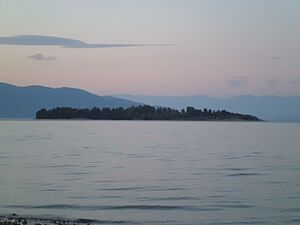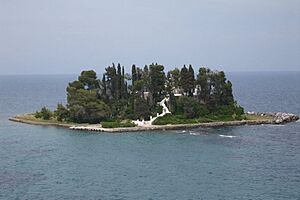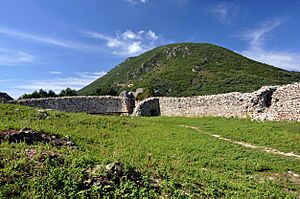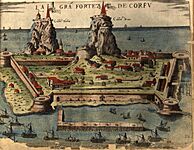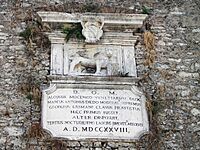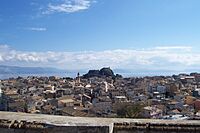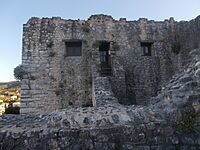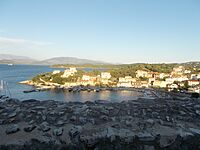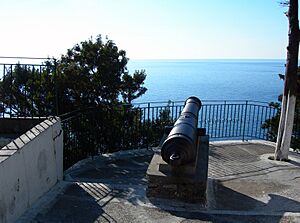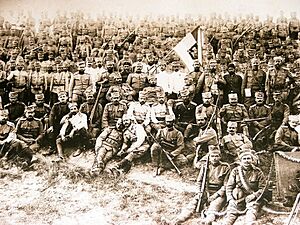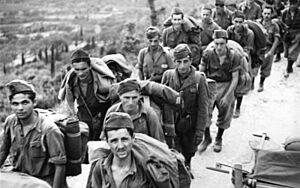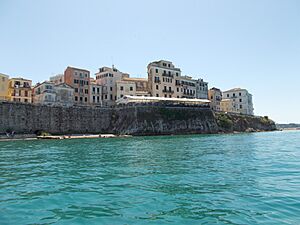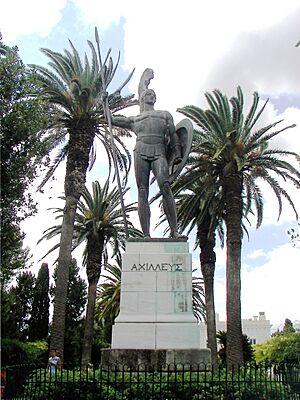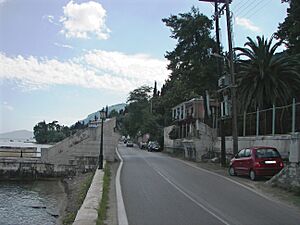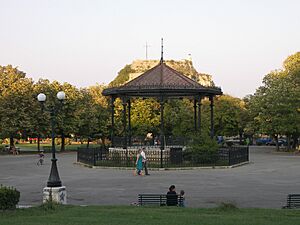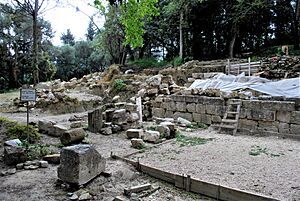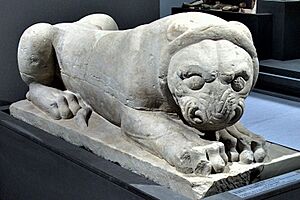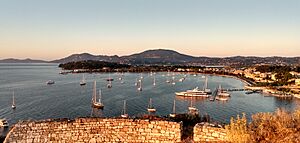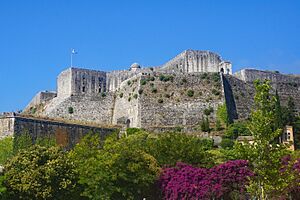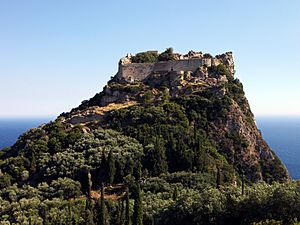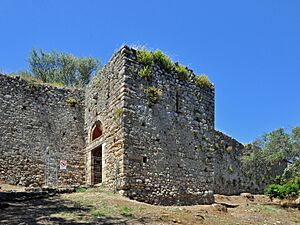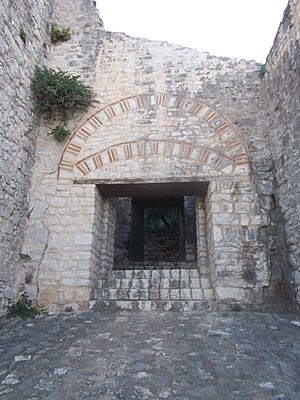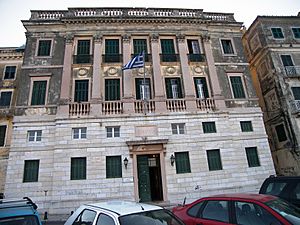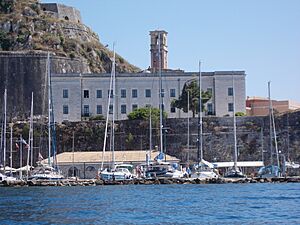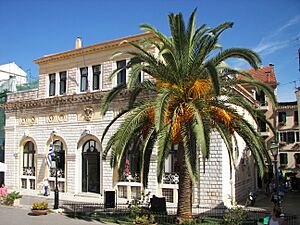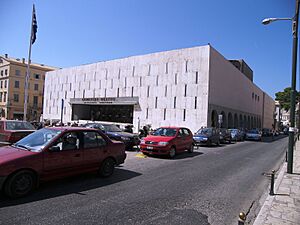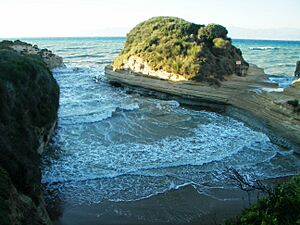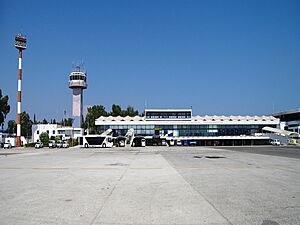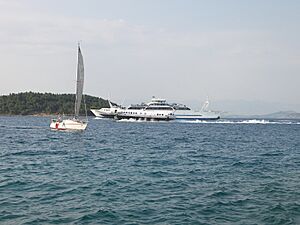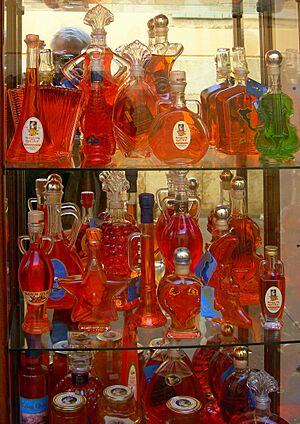Corfu facts for kids
|
Native name:
Κέρκυρα
Nickname: Το νησί των Φαιάκων (The island of Faiakes)
|
|
|---|---|
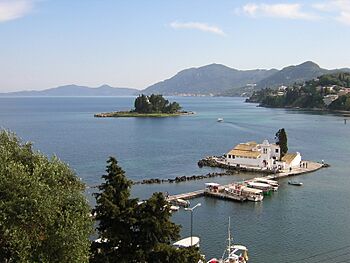 |
|
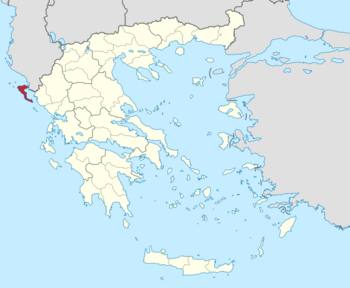 |
|
| Geography | |
| Coordinates | 39°36′N 19°52′E / 39.60°N 19.87°E |
| Area | 610.9 km2 (235.9 sq mi) |
| Highest elevation | 906 m (2,972 ft) |
| Administration | |
| Administrative region | Ionian Islands |
| Regional unit | Corfu |
| Capital city | Corfu |
| Demographics | |
| Demonym | Corfiot, Corfiote |
| Population | 99,134 |
| Pop. density | 163.44 /km2 (423.31 /sq mi) |
| Additional information | |
| Time zone | |
| • Summer (DST) | |
| Postal code | 490 81, 490 82, 490 83, 490 84, 491 31, 491 32 (former 491 00) |
| Area code(s) | 26610, 26620, 26630 |
Corfu (also called Kerkyra in Greek) is a beautiful Greek island in the Ionian Sea. It's part of the Ionian Islands and is located near Albania. The main city on the island is also called Corfu.
Corfu has a very long and exciting history, starting with Greek mythology. Many battles and conquests have taken place here. Ancient Korkyra (Corfu) was a strong naval power. The island has medieval castles that helped protect it from pirates and the Ottoman Turks. Corfu's capital city is unique because it's surrounded by two castles.
For centuries, Corfu was part of the Republic of Venice. It successfully defended itself against many Ottoman attacks, becoming one of Europe's most fortified places. After the Napoleonic Wars, the British ruled Corfu for a while. In 1864, it became part of modern Greece. Corfu was also home to the first university in modern Greece, the Ionian Academy.
In 2007, the UNESCO World Heritage List added Corfu's old town. Today, Corfu is a very popular place for tourists to visit.
Contents
Island Names
The Greek name, Kerkyra, comes from an old myth. It's linked to two powerful water gods: Poseidon, the god of the sea, and Asopos, a Greek river god. The story says Poseidon fell in love with a beautiful nymph named Korkyra. He brought her to this island, which didn't have a name yet. He named the island Korkyra after her. Their child, Phaiax, gave his name to the island's people, the Phaiakes. This is why Corfu is known as the island of the Phaeacians.
The name Corfù comes from the Byzantine Greek word Koryphō. This means "city of the peaks," referring to the two peaks of the Palaio Frourio.
Island Geography
Corfu's northeastern side is close to Sarandë, Albania. The distance across the water is only about 3 to 23 kilometers. The island's shape looks like a sickle. It is about 64 kilometers long and 32 kilometers wide at its widest point.
Two main mountain ranges divide the island. The northern part is mountainous, the middle part has rolling hills, and the southern part is flat. The highest mountain is Mount Pantokrator, which means "the Almighty."
Corfu has many beautiful beaches, like Agios Gordis, Agios Georgios, and Palaiokastritsa. The island is also near a geological fault, so earthquakes can happen.
Corfu's coastline is 217 kilometers long. Its highest point is Mount Pantokrator, at 906 meters.
Nearby Islands
The Diapontia Islands are a group of small islands located northwest of Corfu. They are about 6 kilometers away from Corfu and 40 kilometers from Italy. The main islands are Othonoi, Ereikoussa, and Mathraki.
Lazaretto Island
Lazaretto Island is a small island about 1.1 kilometers off the coast of Corfu city. It's about 7.1 hectares in size. In the 16th century, the Venetians built a monastery and a hospital for people with leprosy there, which is how it got its name.
During World War II, the Nazis used it as a prison camp for members of the Greek Resistance. Today, you can still see the old Italian army headquarters, a small church, and a wall where prisoners were executed.
Island Climate
Corfu has a hot-summer Mediterranean climate. This means it has hot, dry summers and mild, very rainy winters. The highest temperature ever recorded was 42.8°C in July 2007. The lowest was -6.0°C in January 2012.
Nature and Wildlife
Plants
Corfu is famous for its many olive trees and cypress trees, which create a beautiful landscape. Besides these, you can find fruit trees like pear, pomegranate, apple, fig, and grapevines. The island also has special fruits like the kumquat and loquat. In total, over 1800 different plant species have been found here.
Animals
Corfu is a "continental island," meaning its animal life is similar to the nearby mainland.
Birds
About 300 different bird species have been seen on Corfu since the 1800s. These range from large greater flamingos to tiny goldcrests. Some birds, like the eastern imperial eagle, no longer live or breed on the island.
Mammals
Around 40 types of mammals live on the island and in the surrounding sea. You might see different kinds of dolphins and even large whales. Eurasian otters still live in the lagoons and streams. While some animals like golden jackals and wild boars had disappeared, they are now starting to return from the mainland. Common animals include red foxes, European hares, and hedgehogs.
Amphibians and Reptiles
Eight types of amphibians and 31 types of reptiles have been found on Corfu. These include different kinds of newts, toads, and frogs.
Loggerhead sea turtles lay their eggs on the sandy beaches. On land, you can find Hermann's tortoise. In wetlands, there are European pond turtles.
Lizards like the Mediterranean house gecko and the Balkan green lizard are common. Of the snakes, only the nose-horned viper is potentially dangerous. Most snakes on the island are harmless.
Butterflies
There are over 75 known species of butterflies on Corfu. Some interesting ones include the southern swallowtail and the southern festoon. Many of these are considered "near threatened."
In 2019, a group called Corfu Butterfly Conservation (CBC) was started. This group includes local people, visitors, and scientists. They work to collect information about butterflies to help protect them and their habitats. Their website, launched in 2021, lists the 75 confirmed butterfly species on the island.
Island History
Early Times
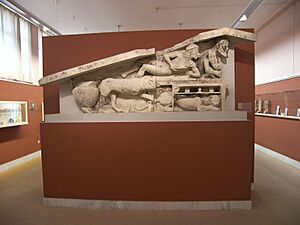
The earliest mention of Corfu is from around 1300 BC. Some scholars believe Corfu is the island of Scheria from Homer's Odyssey, where Odysseus met the Phaeacians. The island was also visited by the Argonauts, according to the story Argonautica.
Around 730 BCE, settlers from Corinth came to Corfu. Because of its good location for trade and its fertile land, Corfu grew quickly. The people of Corfu often disagreed with their mother city, Corinth. This led to the first naval battle recorded in Greek history in 665 BCE.
Corfu was important in the Peloponnesian War, helping the Athenians as a naval base. The island faced many attacks during the Hellenistic period. In 229 BCE, the Illyrians captured it, but the Romans quickly took it over. Corfu remained a Roman naval station for a long time.
Roman and Medieval Times
Christianity came to Corfu early. Two followers of Saint Paul, Jason of Tarsus and Sosipatrus of Patras, taught the Christian message. Their relics were kept in the old cathedral.
In 551, during a war, the city of Corfu was destroyed. The main settlement then moved north to the location of the current Old Fortress. This new spot had natural protection from attacks. The medieval city got its name, Korypho (meaning "city on the peak"), from the two peaks of this new site. This name later became "Corfu."
From the 9th century, Corfu was part of the Byzantine Empire. It was an important stop for travelers between the East and West. However, the island faced new threats from the Normans. The Normans invaded Corfu three times between 1081 and 1185.
After the Byzantine Empire broke up, Genoese privateers occupied the island (1197–1207). Then, in 1214, it became part of the Greek despotate of Epirus. From 1386, the Republic of Venice controlled Corfu. Venice formally took over in 1401 and ruled the island until 1797.
Venetian Rule
For centuries, Corfu was seen as a strong defense for Europe against the Ottoman Empire. The Venetians used the island's strong forts to stop the Ottomans from entering the Adriatic Sea. Corfu successfully fought off several Ottoman sieges. This is why Corfu is one of the few places in Greece that was never conquered by the Ottomans.
The Ottomans tried to take the island many times. In 1431, their troops landed but were pushed back. The first major siege happened in 1537. About 25,000 Ottoman soldiers attacked, pillaging the island and taking 20,000 people as slaves. But the city's castle held strong for twelve days, and the Ottomans left because of problems with supplies and sickness.
In 1571, Ottoman forces returned. They attacked the Paxi islands and landed on Corfu's southeast shore. They pillaged these areas, but the city castle and Angelokastro (another castle) held firm. The Ottomans gave up and left. They tried again two years later, but Venetian-Corfiot forces pushed them back.
The second major siege of Corfu happened in 1716. The Ottoman fleet, carrying 33,000 men, sailed to Corfu. The Venetian fleet defeated them in a naval battle. The Ottoman army then laid siege to Corfu city. But despite many attacks, they couldn't break through the defenses. The 5,000 Venetians and foreign soldiers, along with 3,000 Corfiotes, led by Count Johann Matthias von der Schulenburg, won the battle. This victory was celebrated across Europe. The composer Antonio Vivaldi even wrote an opera called Juditha triumphans to remember this event.
Venetian Influence
Corfu's city architecture is different from other Greek cities because of its unique history. From 1386 to 1797, Venetian nobles ruled Corfu. Many buildings in the city show this Venetian style, with tall buildings on narrow streets. The Old Town of Corfu is a World Heritage Site because of this clear Venetian influence. The first opera house in Greece, the Nobile Teatro di San Giacomo di Corfù, was built during the Venetian period.
Many families who spoke Venetian settled in Corfu. The local Greek language also adopted many Italian and Venetian words, which are still used today. The Venetians also promoted the Catholic Church. Today, most Corfiots are Greek Orthodox, but a small Catholic community still lives there peacefully.
Corfu also became a place for Greek scholars. In 1732, it became home to the first academy of modern Greece. The island's culture also took in Venetian influences in its food. Corfiot cooking includes Venetian dishes like "Pastitsada" and "Sofrito".
-
Panoramic view of Corfu (city) from the New Fortress
19th Century
In 1797, Corfu was given to the French. They ruled it for two years until a combined Russian-Ottoman force expelled them. For a short time, Corfu became the capital of a self-governing group of islands called the "Seven Islands." In 1807, the French took control again.
After Napoleon was defeated, the Ionian Islands became a British protectorate in 1815. Corfu became the main seat for the British governor. During British rule, new roads were built, the water supply improved, and the Ionian Academy grew into a university. Greek became the official language.
In 1864, the Ionian Islands, including Corfu, were united with Greece.
British Governors
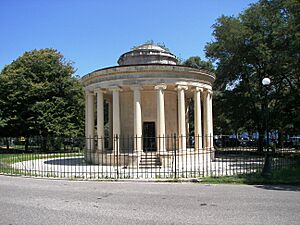
Here are some of the British governors of the Ionian Islands:
- Sir Thomas Maitland (1815–1823)
- Sir Frederick Adam (1823–1832)
- John Colborne, 1st Baron Seaton (1843–1849)
- William Ewart Gladstone (1859)
In 1891, there were riots against Jewish people in Corfu. Some Jewish people left the island, many going to Thessaloniki.
World Wars
During World War I, Corfu became a safe place for the Serbian army. They retreated there on Allied ships after their homeland was taken over. Many Serbian soldiers died from exhaustion and sickness. Most were buried at sea near Vido, a small island near Corfu's port. A monument was built there to thank Greece. The waters around Vido are known as the "Blue Tomb" by Serbians.
In 1923, Italian forces bombed and occupied Corfu after a disagreement with Greece. The League of Nations helped resolve this "Corfu incident."
Italian and German Occupation
During the Greco-Italian War, Italian forces occupied Corfu in April 1941. They wanted Corfu to be part of Italy. Corfiot students protested against the Italian army in 1941, which was one of the first acts of resistance in occupied Greece. Many Corfiots also joined resistance groups on the mainland.
When Italian fascism fell in 1943, the Nazis took control of Corfu. On September 14, 1943, the German air force (Luftwaffe) bombed Corfu. The bombing destroyed many buildings, including churches, homes, and the Jewish quarter. Important buildings like the Ionian Academy and the Municipal Theatre of Corfu were also destroyed.
The Nazis then occupied the island. In June 1944, the Gestapo gathered the Jewish people of Corfu. They were sent to Auschwitz concentration camp, where most were killed. About 200 out of 1,900 Jews managed to escape, often hidden by local people. Today, there is still a synagogue in the Jewish quarter with about 65 members.
Liberation
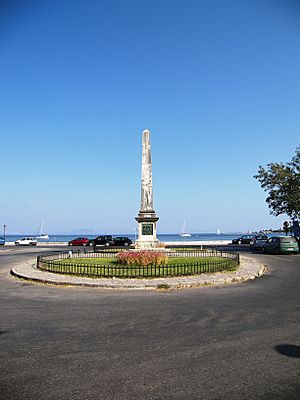
British troops liberated Corfu on October 14, 1944, as the Germans were leaving Greece. Later, a dispute between the United Kingdom and Albania over mines in the Corfu Channel led to a case in the International Court of Justice.
Modern Corfu
After World War II and the Greek Civil War, Corfu was rebuilt. Its economy grew, but some people left the island. Electricity came to villages in the 1950s, and television in the 1960s. The Ionian University was founded in 1984.
In 1956, Maria Desylla Kapodistria became the first female mayor in Greece, serving Corfu.
Architecture
Venetian Style
Corfu's city architecture is heavily influenced by Venice. This is because the Venetians ruled the island for over 400 years (1386 to 1797). The Old Town of Corfu has narrow streets called kantounia and buildings with arches, which remind people of Venice. It is a World Heritage Site.
Other famous Venetian-era buildings include the Nobile Teatro di San Giacomo di Corfù, which was Greece's first opera house. Liston is a building with arches, cafes, and restaurants, located next to the main square, Spianada. The Spianada is a large park with a cricket field and the Maitland monument. The Palace of St. Michael and St. George was once the home of the British governor and the Greek royal family. The summer palace of Mon Repos is also notable.
The Achilleion Palace
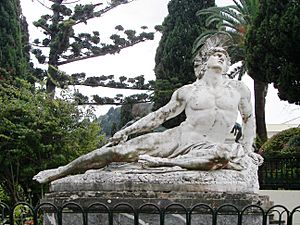
In 1889, Empress Elisabeth of Austria built a summer palace south of Corfu city. She named it Achílleion after the Greek hero Achilles. The palace is filled with paintings and statues of Achilles, showing scenes from the Trojan War. It was a peaceful retreat for the Empress after her son's death.
The palace gardens offer views of the green hills and the Ionian Sea. A famous marble statue in the gardens shows the dying Achilles, trying to pull Paris's arrow from his heel. This statue was made by German sculptor Ernst Gustav Herter.
In 1898, Empress Sissi was assassinated. The palace was then sold to the German Kaiser Wilhelm II. The Kaiser added another large statue of Achilles. He had an inscription placed at its base that read: "To the Greatest Greek from the Greatest German." This inscription was removed after World War II.
Today, the Achilleion is owned by the Greek state and is a museum.
Kaiser's Bridge
Kaiser Wilhelm II also loved vacationing in Corfu. After buying the Achilleion in 1907, he built a bridge, known as the "Kaiser's bridge." This bridge allowed him to go from the palace gardens directly to the beach without crossing the main road. The middle part of the bridge was destroyed by the German army in 1944 to make way for a large cannon. Its remains are still a landmark today.
City Landmarks
Old Town
The Old Town of Corfu city is a UNESCO World Heritage Site. Many buildings from the Venetian era can be found here. The old city's architecture is strongly Venetian, with narrow, cobblestone streets called kantoúnia. Many of these streets are too narrow for cars.
A walkway runs along the seashore towards Garitsa Bay. Between the city and the citadel is a large open space called Spianada. On its west side is the Liston arcade, with many restaurants and cafes. The Liston is often used for parades and gatherings.
Spianada Square
Near the old Venetian Citadel is the large Spianada square. It's divided into "Ano Plateia" (Upper square) and "Kato Plateia" (Lower square). This is one of the biggest squares in Europe. It has green spaces and interesting structures, like the Maitland monument, built to remember Sir Thomas Maitland. There's also a beautiful music pavilion where local Philharmonic Orchestras perform free concerts. "Kato Plateia" is sometimes used for cricket matches, a sport unique to Corfu in Greece due to British influence.
Palace of Saints Michael and George
North of "Kato Plateia" is the "Palaia Anaktora" (Old Palaces). This large complex of buildings, in Roman style, used to be home to the Kings of Greece and before that, the British governors. It was called the Palace of Saints Michael and George. Today, the palace is open to the public and houses an Asian Art Museum, which has a unique collection of Chinese and Asian art.
The palace gardens have old Venetian stone aquariums, exotic trees, and flowers. They overlook the bay through old Venetian forts. There's also a cafe with an art gallery. From here, you can see ships passing by Vido island on their way to Corfu harbor. The old Royal Gardens are now called the "Garden of the People."
Churches
Corfu city has 37 Greek churches. The most important ones are the city's cathedral, the church of Our Lady of the Cave, and Saint Spyridon Church, which holds the preserved body of the island's patron saint. The church of St Jason and St Sosipater is believed to be the oldest on the island.
Pontikonisi Island
The small island of Pontikonisi (meaning "mouse island") is very green and covered with trees. It's home to the Pantokrator monastery. The monastery's white stone staircase, when seen from a distance, looks like a mouse tail, which gave the island its name.
Archaeological Sites
Palaiopolis
In Corfu city, you can find the ruins of the ancient city of Korkyra, also known as Palaiopolis. These ruins include ancient temples that were found at the site of the Mon Repos palace. The temples are: Kardaki Temple, Temple of Artemis, and the Temple of Hera. Hera's temple was built on top of Analipsis Hill, making it easy to see from ships.
Kardaki Temple
Kardaki Temple is an ancient Greek temple in Corfu, built around 500 BC. It's unusual because it doesn't have a frieze, which is a decorative band found on most Greek temples. This makes it a unique example of ancient Greek architecture. Its purpose or the god it was dedicated to is not fully known.
Temple of Artemis
The Temple of Artemis is an ancient Greek temple in Corfu, built around 580 BCE. It was dedicated to Artemis, the goddess of the hunt. It's known as the first Greek temple built entirely of stone and the first to include all parts of the Doric order architectural style. Large pieces of its decorative carvings (pediment) have survived, showing scenes like the Gorgon Medusa.
The temple was very large for its time, measuring about 23.46 meters wide and 49 meters long. It faced east to let in the morning light. The German Kaiser Wilhelm II was involved in excavations at this site while vacationing in Corfu.
Temple of Hera
The Temple of Hera, or Heraion, is another ancient Greek temple in Corfu. It was built around 610 BCE within the Mon Repos estate. This temple is considered a major example of early Greek architecture.
Its roof was decorated with large, colorful figures like lions and gorgoneions (Medusa heads). This made it one of the most decorated temples of its time. The temple was built on Analipsis Hill, so it was very visible to ships approaching the ancient city.
A project called the Digital Archaic Heraion Project at Mon Repos is working to create a 3D digital model of the temple using fragments found at the site.
Tomb of Menecrates
The Tomb of Menecrates is an ancient tomb in Corfu, built around 600 BCE. It was found in 1843 by the British Army. A large stone lion statue was also found nearby, which is one of the earliest funerary lions ever discovered.
An ancient Greek inscription on the tomb says it was built to honor Menecrates, an ambassador from Korkyra who was lost at sea. His brother helped the people of Korkyra build this monument.
Castles
Corfu's castles are located at important points around the island. They helped defend the island from many invaders, especially during the Ottoman sieges. These castles played a big part in keeping Corfu free from Ottoman rule.
Old Fortress

The Old Fortress (Palaio Frourio) is an old Venetian fort built on an artificial island. It has strong walls all around it. Parts of the fort are used for cultural events like concerts and light shows, which tell historical stories with sound and light effects. Inside the fort, there's St. George's church, which has a classical style with Doric columns, unlike most Greek Orthodox churches.
New Fortress
The New Fortress (Neo Frourio) is a huge complex of forts built by the British when they ruled the island (1815–1863). It stands over the northeastern part of Corfu city. The fortress walls are very impressive as you approach the city from the new port. The New Fortress used to be a military area, but now it's open to the public. You can explore its medieval corridors and fortifications. You'll often see the winged Lion of St Mark, the symbol of Venice, on the walls.
Angelokastro Castle
Angelokastro (meaning "Castle of the Angel") is a Byzantine castle on the northwest coast of Corfu, near Palaiokastritsa. It's built on a very steep and rocky cliff, about 300 meters above the sea. From here, you can see Corfu city and the mountains of mainland Greece.
Angelokastro was a very important defensive point. It formed a defensive triangle with Gardiki Castle and Kassiopi Castle, protecting Corfu from different directions. The castle was never captured, even after many sieges. It played a key role in defending the island against pirates and during three Ottoman sieges, helping to defeat them. When invaders came, it also provided shelter for local villagers, who helped defend it.
Gardiki Castle
Gardiki Castle is a 13th-century Byzantine castle on the southwestern coast of Corfu. It's the only medieval fortress still standing in the southern part of the island. A ruler from the Despotate of Epirus built it.
Gardiki's location helped protect the fields and lowlands of southern Corfu. Along with Kassiopi Castle in the northeast and Angelokastro in the northwest, it formed a triangle of defense for Corfu before the Venetian era.
Kassiopi Castle
Kassiopi Castle is on the northeastern coast of Corfu, overlooking the fishing village of Kassiopi. It was one of three Byzantine-era castles that defended the island before the Venetian rule. Its position overlooking the Corfu Channel gave it a very important strategic location.
Kassiopi Castle is considered one of the most impressive old buildings in the Ionian Islands. Since it was left abandoned for a long time, much of it is in ruins. Some of its stones were even used to build houses nearby. You can access the castle mainly from the southeast, through narrow paths that pass by homes.
Education
Ionian Academy
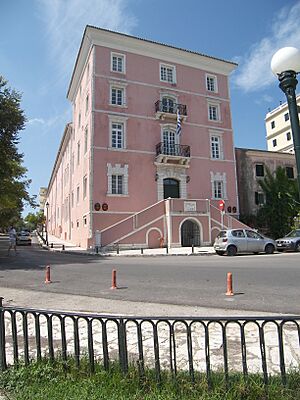
The Ionian Academy was an important school that kept Greek education alive when most of Greece was under Ottoman rule. The French started the academy, and it became a university during the British rule in 1824. It's considered the first university in modern Greece. It had schools for language, law, and medicine.
Ionian University
The Ionian University was founded in 1984. This was to recognize Corfu's important role in Greek education, as it was home to the first modern Greek university. The university opened in 1985 and now has three Schools and six Departments. It offers many different study programs and summer schools.
Student Activism
Students in Corfu have a history of protesting for freedom and democracy. During World War II, they held large protests against the fascist occupation. They also protested against the dictatorship of Georgios Papadopoulos (1967–1974). A famous example is Kostas Georgakis, a geology student who set himself on fire in Italy in 1970 to protest the Greek military government.
Culture
Corfu has a rich tradition of music, theater, and opera. Operas performed in Corfu were considered as good as those in other European cities. The phrase "applauded in Corfu" meant an opera was very successful. The Nobile Teatro di San Giacomo di Corfù was the first theater and opera house in modern Greece. The first Greek opera, The Parliamentary Candidate, was performed there.
Museums and Libraries

Corfu has several notable museums and libraries, mostly in Corfu city:
- The Archaeological Museum: Opened in 1967, it houses the huge Gorgon carving from the Artemis temple. This carving is considered one of the best examples of ancient temple sculpture.
- The Museum of Asian Art: Located in the Palace of St. Michael and St. George, it has over 12,000 artifacts, including Chinese, Japanese, and even Greco-Buddhist art.
- The Banknote Museum: Shows a complete collection of Greek banknotes from independence until the euro was adopted in 2002.
- The Byzantine Museum of Antivouniotissa: A church turned into a museum, featuring rare Byzantine art.
- Kapodistrias Museum: The summer home of Ioannis Kapodistrias, the first governor of independent Greece, is now a museum about his life.
- The Serbian Museum of Corfu: Shows exhibits about the Serbian soldiers who found refuge in Corfu during World War I. It includes photos, uniforms, and weapons.
Patron Saint Spyridon
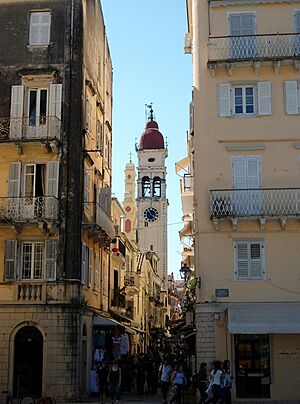
Saint Spyridon is the patron saint of Corfu city and the island. People believe he performed many miracles, including saving the island from the plague. He is also credited with saving the island during the second great siege of Corfu in 1716. Legend says he appeared to the Ottoman forces, causing them to panic and retreat.
Because of this victory, Venice declared that a special procession (litany) for St. Spyridon should be held every year on August 11. This tradition continues today. Many boys born on the island are named Spyridon.
Music
Musical History

While much of Greece was under Ottoman rule, the Ionian Islands, especially Corfu, had a "Golden Age" of music and opera. Corfu was the capital of a Venetian area and developed a unique musical heritage. In the 19th century, under British rule, Corfu's music became the foundation of modern Greek music. The Teatro San Giacomo (now the City Hall) was the first theater in Greece after 1452.
Corfu was also the center of the Ionian School of music. This was the first school of classical music in Greece, and it greatly influenced later Greek music after the Greek War of Independence.
The Three Philharmonics
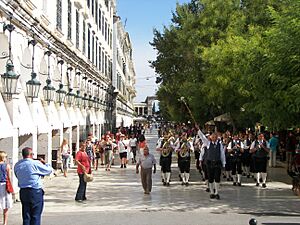
Corfu's Philharmonic Societies offer free music lessons and attract many young musicians. There are 19 such marching bands across the island. Corfu city is home to the three most famous bands:
- The Philharmonic Society of Corfu (the Old Philharmonic), founded in 1840. They wear dark blue uniforms.
- The Mantzaros Philharmonic Society (the New), founded in 1890. They wear blue uniforms.
- The Capodistria Philharmonic Union (the Cónte), founded in 1980. They wear bright red and black uniforms.
These bands perform regularly at the Spianada Green and play a big part in the yearly Holy Week ceremonies.
Ionian University Music Department
Since the early 1990s, the Ionian University has had a music department. Besides teaching, it organizes concerts and research. Every summer, it hosts an international music academy, bringing together students and professors from around the world.
Theaters and Opera
Teatro di San Giacomo
Under Venetian rule, Corfiots loved Italian opera. This led to amazing musical growth on the island. The Nobile Teatro di San Giacomo di Corfù was Corfu's opera house in the 18th and 19th centuries. It was the first theater and opera house in modern Greece. The first Greek opera was performed there. Many local composers started their careers at this theater.
For almost 200 years, from 1771 to 1943, nearly every major Italian opera, and many Greek and French ones, were performed at San Giacomo. This tradition continues in Corfu's opera history.
Municipal Theatre of Corfu
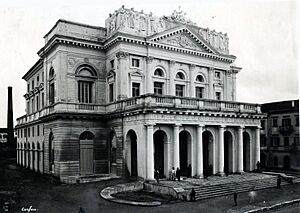
The Municipal Theatre of Corfu was the main theater and opera house in Corfu. It opened in 1902, replacing the Nobile Teatro di San Giacomo. Sadly, it was destroyed during a German air raid in 1943.
For 41 years, it was one of the best theaters in Greece and contributed greatly to the arts in Europe. The theater's archives, including those from San Giacomo, were all destroyed in the bombing. This included many original works by composers.
Festivities
Easter
On Good Friday, the three Philharmonic Societies' bands accompany the Epitaph processions of the city churches. Later, they join together for the cathedral's procession. Each band plays different funeral marches.
On Holy Saturday morning, the bands join the Epitaph procession of St. Spyridon Cathedral with the Saint's relics. They play different funeral marches again. This tradition started in the 19th century when British rulers tried to ban the bands from the Good Friday procession. The Corfiots defiantly held the procession the next morning with St. Spyridon's relics.
After the procession, at 11:00 AM, people celebrate the "Early Resurrection." Balconies in the old city are decorated with red cloth. Corfiots throw large clay pots (bótides) full of water onto the street. This is done to celebrate the upcoming Resurrection of Jesus and to remember a verse from the Bible.
After the pots are smashed, the three bands parade through the streets, playing the famous "Graikoí" festive march. This march is like the island's anthem.
Carnival
Another old Corfu tradition is the Carnival, or Ta Karnavalia. It comes from Venetian times. The festivities include a parade with a main character called Karnavalos, a large, smiling figure. People dress in colorful costumes and follow the parade, dancing and socializing in the narrow streets. At night, there are traditional dance and costume parties.
Cultural Depictions
In Myths
- It's said that Heracles fell in love with the naiad Melite in Corfu.
- Corfu was a safe place for the Argonauts after they took the Golden Fleece.
- In Homer's Odyssey, Kerkyra is the island of the Phaeacians, where Odysseus met Nausicaa. Many believe Palaiokastritsa bay is where Odysseus landed.
In Books
- British naturalist Gerald Durrell wrote three books about his childhood in Corfu: My Family and Other Animals, Birds, Beasts and Relatives, and The Garden of the Gods.
- His brother, author Lawrence Durrell, also wrote about Corfu in Prospero's Cell.
- Mary Stewart's novel This Rough Magic is set in Corfu.
- Some say Shakespeare's play The Tempest was inspired by Corfu.
- Albert Cohen, who was born on the island, wrote three books partly set in Corfu.
In Movies and TV
- Corfu was a main location for the 1970 film The Executioner.
- Parts of The Burglars (1971) were filmed in Corfu.
- The Countess of Corfu (1972) was filmed on the island.
- Many scenes from the 1978 film Fedora were set and filmed in Corfu.
- Some scenes from the 1978 film The Greek Tycoon were filmed in Corfu.
- The 1981 James Bond movie For Your Eyes Only has several scenes filmed in Corfu. This includes an underwater temple scene, a casino scene at the Achilleion, and a beach buggy chase at Issos Beach.
- The 1987 BBC TV series and 2005 BBC movie of My Family and Other Animals are set in Corfu.
- ITV aired a TV series called The Durrells in Corfu from 2016 to 2019, based on Gerald Durrell's childhood.
Tourism
Corfiots have always been welcoming to visitors. The northeast coast has many holiday villas. There are also many package holiday resorts on the north, east, and southwest coasts. Since 2021, there's a "Corfu Island Pass" that gives discounts on tours and rentals.
Kavos in the south is another popular tourist resort. St George South has the island's largest sandy beach. The Korission lake nature reserve is a stopover for migrating birds.
In the past, mainly European royals and wealthy people visited Corfu, like Emperor Wilhelm II of Germany and Empress Elisabeth of Austria. Today, it's also very popular with middle-class families, especially from the UK, Scandinavia, and Germany.
Transport
Corfu has two main highways: GR-24 in the northwest and GR-25 in the south.
The island has ferry services to Paxoi island and to Patras on the mainland. There are also high-speed "Flying Dolphins" ferries to Igoumenitsa in Greece and Sarandë in Albania. A smaller port in Lefkimmi also offers ferry services to the mainland.
The Ioannis Kapodistrias International Airport is named after Ioannis Kapodistrias, the first governor of independent Greece. It's located about three kilometers south of Corfu city. When planes land from the northeast, passengers get great views of Pontikonisi and Vlaheraina Monastery. The airport has domestic flights and used to have seaplane services to other islands and Italy.
Buses run regularly between Corfu city and major towns and beaches. There are also coaches that go to Athens and Thessaloniki. City buses connect the city to the Airport, Achilleion, and other places of interest. The Diapontia Islands can be reached by boat from Corfu port.
Economy
Corfu is mostly covered with olive groves and vineyards. It has produced olive oil and wine since ancient times. The main wine grapes grown here are Kakotrýgēs (white) and Petrokóritho (red).
In modern times, new crops like the kumquat and bergamot oranges have been introduced. These are used to make delicious spoon sweets and liqueurs. Corfu also produces local foods like Corfiote graviéra cheese, "Corfu butter" (made from ewe's milk), and noúmboulo salami.
Local dishes include sofrito (a veal roast), pastitsáda (pasta with veal in tomato sauce), bourdétto (cod in a peppery sauce), and sweets like mándoles (caramelized almonds) and mandoláto. Corfu also makes its own ginger beer called tzitzibíra, a leftover from the British era.
The island is an important port and trades a lot in olive oil.
Images for kids
-
Gardens of Achilleion
-
Statues at the Achilleion terrace
See also
 In Spanish: Corfú para niños
In Spanish: Corfú para niños


